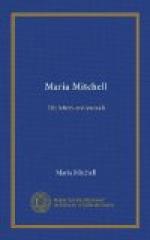“3. This communication must be made by the first post after the discovery. If there is no regular mail at the place of discovery, the first opportunity of any other kind must be made use of, without waiting for other observations. Exact compliance with this condition is indispensable. If this condition is not complied with, and only one person discovers the comet, no medal will be given for the discovery. Otherwise, the medal will be assigned to the discoverer who earliest complies with the condition.
“4. The communication must not only state as exactly as possible the time of the discovery, in order to settle the question between rival claims, but also as near as may be the place of the comet, and the direction in which it is moving, as far as these points can be determined from the observations of one night.
“5. If the observations of one night are not sufficient to settle these points, the enunciation of the discovery must still be made, in compliance with the third article. As soon as a second observation is made, it must be communicated in like manner with the first, and with it the longitude of the place where the discovery is made, unless it take place at some known observatory. The expectation of obtaining a second observation will never be received as a satisfactory reason for postponing the communication of the first.
“6. The medal will be assigned twelve months after the discovery of the comet, and no claim will be admitted after that period.
“7. Messrs. Baily and Schumacher are to decide if a discovery has been made. If they differ, Mr. Gauss, of Goettingen, is to decide.
“8. Messrs. Baily and Schumacher have agreed to communicate mutually to each other every announcement of a discovery.
“Altona, April, 1840.”
On the 1st of October, 1847, at half-past ten o’clock, P.M., a telescopic comet was discovered by Miss Maria Mitchell, of Nantucket, nearly vertical above Polaris about five degrees. The further progress and history of the discovery will sufficiently appear from the following correspondence. On the 3d of October the same comet was seen at half-past seven, P.M., at Rome, by Father de Vico, and information of the fact was immediately communicated by him to Professor Schumacher at Altona. On the 7th of October, at twenty minutes past nine, P.M., it was observed by Mr. W.R. Dawes, at Camden Lodge, Cranbrook, Kent, in England, and on the 11th it was seen by Madame Ruemker, the wife of the director of the observatory at Hamburg. Mr. Schumacher, in announcing this last discovery, observes: [Footnote: “Astronomische Nachrichten,” No. 616.] “Madame Ruemker has for several years been on the lookout for comets, and her persevering industry seemed at last about to be rewarded, when a letter was received from Father de Vico, addressed to the editor of this journal, from which it appeared that the same comet had been observed by him on the 3d instant at Rome.”




